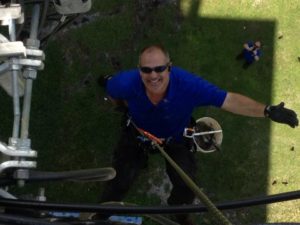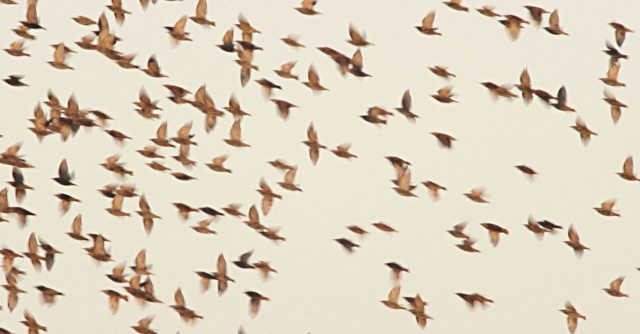How can I remove bird nests from the gutters of my building?
Bird nests in gutters are more common in arid climates because pest birds will find a section of gutter that is covered by a section of roof and think it’s a great spot to build a nest during a dry spell. One good rain, or several days of constant rain, will dissuade the bird and cause them to abandon the nest. But, now you have a section of gutter with an unsightly nest that is probably clogging a downspout.
There are several products made to either clean or cover the tops of gutters to prevent the accumulation of leaves. These products will also help with bird nests. Some cleaning products attach to an exterior/garden hose and extend, so a ladder is not always required. Products that cover the gutter top serve a dual purpose – keeping both leaves and pest birds out of the “U” channel. These may require professional installation, especially in a multi-level facility.
How can businesses stop birds from building nests?
Birds can build nests in many different places. For example, pigeons prefer a flat surface that is at least two-inches wide, closed on one side and covered. Sparrows and starlings prefer a crevice, like those inside a wall to ceiling joint, between your store sign and the wall, or in a damaged vent.
The best way to stop birds from building a nest at your location is to physically eliminate areas that could be potential nesting sites by using one of several Bird Exclusion solutions offered by Copesan.
Birds have nested in my building’s vents. Is this a fire hazard?
While pest birds are not likely to nest in a dryer or other vent that is used regularly, if one has nested, there could be a potential fire hazard. Vents that do not vent high-speed, hot airflow (exhaust fans and attic vents for example) do not pose as much of a fire risk as dryer vents do, but the accumulation of combustible nesting material inside a confined space is never a good idea.
Pests birds can also use a damaged vent, or poke a hole in one, to gain entry into a building.
Properly covering all vents, including the downward facing linear ones along the eaves of a soffit, is a good preventative measure. When covering a dryer vent, it is very important that materials used are specifically for that purpose. Improperly covering a dryer vent can increase the chance of fire, creating an even greater hazard, due to the accumulation of lint.
What is the best bird deterrent?
There are no “silver bullets” in pest bird exclusion. In other words, there is no one best bird deterrent. That said, some deterrent solutions generally work better than others, and some work better for specific species. There are many variables involved in identifying the right solution for a specific problem. Your best solution to deter birds is consulting with a Copesan bird professional. They will consider all the variables and potential solutions available and match them to your specific needs.
If you remove a bird’s nest, will they still come back?
It is important to note that some birds are protected, and it is against the law to disturb their nests. Be sure to check your state DNR guidelines, or consult a professional before removing a bird nest. These violations are taken very seriously and will result in fines.
Whether or not a bird will return if you remove their nest depends highly on the species of bird. However, regardless of species, if you do nothing to keep birds from building a new nest, they will likely return to build in the same place.
If your facility offers conditions that make it an ideal nesting place for birds, just removing the one nest won’t resolve the issue. It is likely the birds will return and set up shop just a few feet from where their original nest was, or in a new area of your facility. Some pest birds, especially pigeons, imprint on their birth site and are very persistent.
If you’re not sure how to proceed, give Copesan a call to find the best solution for your facility.
Our facility has birds in the rafters. Is this a health risk?
The risk associated with birds in the rafters of a commercial facility is not as much with the birds themselves as it is with their droppings. A lot of the risk depends on the species, the type of building and the health of its occupants.
If the birds are pigeons, the risk dramatically increases. Pigeons are 100% non-migratory and raise 8-12 fellow non-migratory young per year. One breeding couple can grow to a flock of 24 in two short years, with each member dropping an average of 25 pounds of waste per year, much of it in their roosting site (your rafters and whatever is below them).
The remediation of the area that birds are roosting in to eliminate the health risk can be the real challenge. Locations like healthcare facilities, schools and businesses that handle food are at the greatest risk. An ounce of prevention will go a long way to mitigate the risks associated with pest birds and their droppings.
In addition to resolving existing bird challenges, Copesan can provide you with a preventative, proactive solution.
About our bird expert: Rolando “Rolie” Calzadilla is the current Bird and Wildlife Technical Manager. With a background in both construction and bird management, Rolie demonstrates extensive knowledge and expertise in solving commercial bird problems. To quote Rolie, “pest control and construction meet at birds.”

Rolie Calzadilla, not afraid to go to great heights to solve your bird problems.

